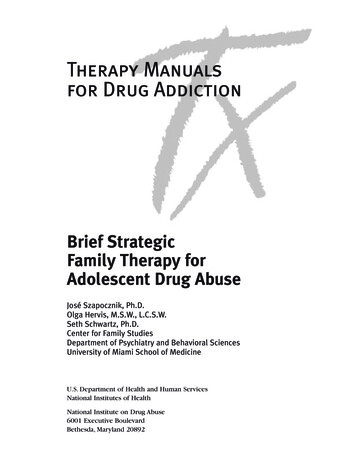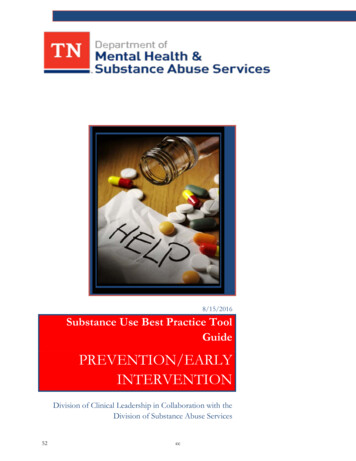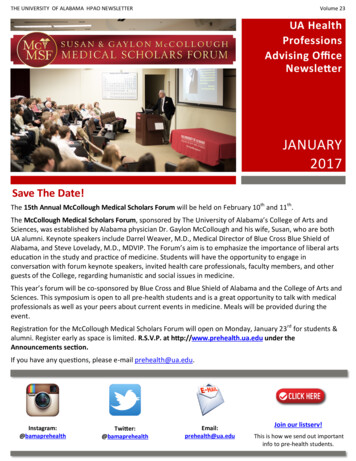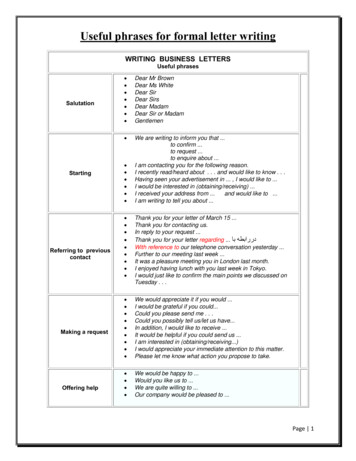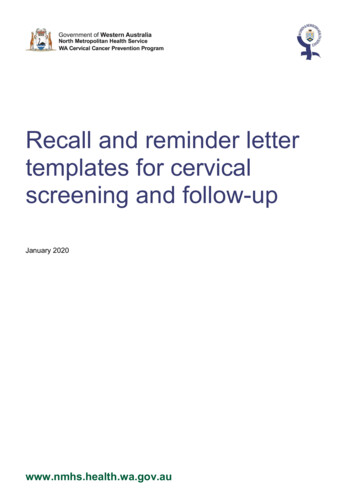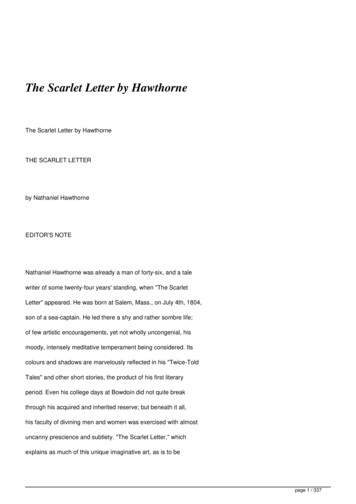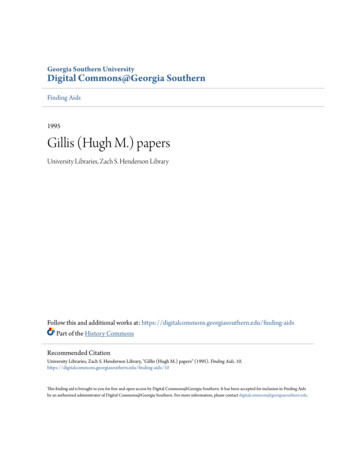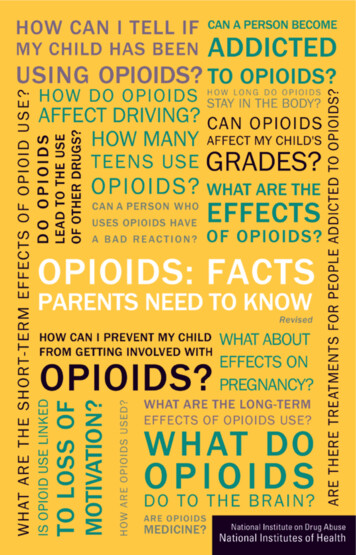
Transcription
A Letter to ParentsYou have probably heard a lot about the opioid crisis in thenews lately. But what are opioids, and what do they have todo with you as the parent of a teenager?If your child has had a sports injury, dental work, or surgery,it is possible that he or she was prescribed a pain reliever thatcontained an opioid. Opioids can be very effective at reducingsevere pain in the short term, such as after surgery, but theycan be very addictive, especially if they are misused.Children and adolescents are at greater risk than adults ofbecoming addicted when exposed to drugs. Particularly whenused in treating children or adolescents, opioids should only betaken to manage severe pain, when no other pain medicine works,and for the shortest time necessary — and most importantly, onlywhile under the careful watch of a trained health care provider.In addition to opioids prescribed for treating pain, thereare powerful opioids sold on the street and used solely toget high, including heroin and illicit fentanyl. These are alsohighly addictive. All opioids — particularly when misused toget high, when combined with other drugs like alcohol ortranquilizers, or when used for pain without proper medicalsupervision — can result in deadly overdoses.1
While opioid misuse in teens has been going down, the rate of opioidmisuse increases significantly after the age of 18, so it is critical to talkwith teens early and frequently to protect them from experimentingwith opioids as they transition into adulthood. Talking to your kidsabout drugs may not be easy, but it is important.Here at the National Institute on Drug Abuse (NIDA), we developedthis guide to help parents talk with their kids. We also have acompanion book, Opioid Facts for Teens, that you can share.Sometimes, just beginning the conversation is the hardest part.I hope these booklets can help.Nora D. Volkow, M.D.DirectorNational Institute on Drug Abuse2
3
ContentsA Letter to Parents. 1I. Talking to Your Kids: Communicating the Risks. 5Did you know?. 6Opioid misuse can have lasting effects. 6Opioids can be addictive. 6Opioid use can affect every area of your teen’s life. 6II. Want to know more? Some FAQs about Opioids. 7What are opioids?. 7What is heroin?. 7What is the connection between prescription opioids and heroin?. 8What are the effects of heroin on the brain, body, and behavior?. 8What are the most commonly used prescription opioids?. 9How do opioids affect the brain and make people feel high?. 9What are the health effects of opioids?. 9How do people use opioids?. 10How many teens misuse opioids?. 12Why do young people use opioids?. 13How can I prevent my child from misusing opioids?. 14Can my teen take someone else’sprescription opioids if he or she is injured?. 14I’ve heard of something called fentanyl. What is that?. 14How can I tell if my child has been misusing opioids?. 15Can my child use opioids if she is pregnant?. 15What is dependence and how is it different from addiction?. 15Can opioid addiction be treated?. 16Can you overdose on opioids?. 16Withdrawal symptoms. 17Can you stop an opioid overdose as it is happening?. 18What is being done to address the opioid overdose crisis?. 19III. Starting the Conversation. 21IV. Other Useful Resources. 234
I. Talking to Your Kids:Communicating the Risks5
Did you know?Opioid misuse can have lasting effects. When opioidsare misused, they can have harmful effects on your brain,like slowed breathing. Slowed breathing can then lead toshort-and long-term health effects, including coma, braindamage, and death. Some studies have shown that repeatedopioid misuse also can affect people’s behavior, decision-making,and responses to stressful situations. So, it’s important tobe aware of any changes in your teen’s behavior.Opioids can be addictive. Opioids are among the mostaddictive drugs. Over time, opioids can change the brain,which leads to addiction. People who are addicted to opioidscan feel a strong need to take the drug again and again. Theymay also experience severe withdrawal symptoms in the absenceof the drug. These negative withdrawal symptoms, coupled withthe strong desire to use opioids, are why some people continueto use opioids, despite negative consequences to their healthand well-being.Opioid use can affect every area of your teen’s life. Usingdrugs early in life can lead to poor grades and bad relationshipswith friends and family. Opioid use can alter judgment and make itmore likely your teen could make risky decisions like havingunprotected sex or driving under the influence.1–31 Dahl RE. Adolescent brain development: a period of vulnerabilities and opportunities.Keynote address. Ann N Y Acad Sci. 2004;1021:1-22. doi:10.1196/annals.1308.0012 Kessler RC, Berglund P, Demler O, Jin R, Merikangas KR, Walters EE. Lifetime prevalence andage-of-onset distributions of DSM-IV disorders in the National Comorbidity Survey Replication.Arch Gen Psychiatry. 2005;62(6):593-602. doi:10.1001/archpsyc.62.6.5933 Thornberry TP, Krohn MD, eds. Taking Stock of Delinquency - An Overview of Findings.New York, NY: Springer Science & Business Media; 2006. //www.springer.com/us/book/9780306473647. Accessed November 7, 2017.6
II. Want to know more?Some FAQs about OpioidsWhat are opioids?There are legal opioids like prescription pain relieversand illegal opioids like heroin and illicit fentanyl.Prescription opioids are powerful pain-reducing medications.Some prescription opioids are made directly from the opiumpoppy plant. Others are made by scientists in a laboratoryalthough they have similar chemical structures.Heroin is an OpioidWhat is heroin?Heroin is an addictive illegal drug made from morphine, a naturalsubstance that is found in the seed pod of opium poppy plants inSoutheast and Southwest Asia, Mexico, and Colombia. It is a typeof opioid. Heroin can come in powder form or as a black stickysubstance. Heroin can be injected, sniffed, snorted, or smoked.Heroin may have many street names including Big H, Black Tar,Chiva, Hell Dust, Horse, Negra, Smack, and Thunder.7
What is the connection between prescriptionopioids and heroin?Prescription pain relievers and heroin are chemically similar andproduce similar effects. You can become addicted to both andoverdose on both. Some people get addicted to prescriptionopioids and then switch to heroin. Others simply start using heroin.In some communities, heroin is cheaper and potentially easier toget than prescription opioids, which is why some people who areaddicted to prescription opioids sometimes switch. Data from 2011showed that an estimated 4 to 6 percent who misuse prescriptionopioids switch to heroin 4 – 6 and about 80 percent of people whoused heroin first misused prescription opioids.4 – 6More recent data suggest that heroin is frequently the first opioidpeople use. In a study of those entering treatment for opioid usedisorder, approximately one-third reported heroin as the firstopioid they used regularly to get high.7What are the effects of heroin on the brain,body, and behavior?Just like other opioids, heroin binds to the opioid receptors in thebrain and body, causing euphoria and relieving pain. This meansthat the short-term and long-term effects will be similar to thoseexperienced from prescription opioids. However, people whoinject heroin can also experience collapsed veins.Additionally, people who inject drugs increase their risk ofgetting HIV or hepatitis C. These diseases are passed fromperson to person through blood and other bodily fluids. Whenpeople share needles or other drug equipment, they can comeinto contact with these fluids. HIV, and less often hepatitis C,can also be spread through unprotected sex.4 Muhuri PK, Gfroerer JC, Davies MC. Associations of Nonmedical Pain Reliever Use andInitiation of Heroin Use in the United States. CBHSQ Data Rev. August 2013.5 Cicero TJ, Ellis MS, Surratt HL, Kurtz SP. The Changing Face of Heroin Use in the UnitedStates: A Retrospective Analysis of the Past 50 Years. JAMA Psychiatry. .366.6 Carlson RG, Nahhas RW, Martins SS, Daniulaityte R. Predictors of transition to heroin useamong initially non-opioid dependent illicit pharmaceutical opioid users: A natural historystudy. Drug Alcohol Depend. 2016;160:127-134. doi:10.1016/j.drugalcdep.2015.12.026.7 Cicero TJ, Ellis MS, Kasper ZA. Increased use of heroin as an initiating opioid of abuse. AddictBehav. 2017 Nov;74:63-66. doi: 10.1016/j.addbeh.2017.05.030. Epub 2017 May 23. PubMedPMID: 28582659. https://www.ncbi.nlm.nih.gov/pubmed/285826598
What are the most commonly usedprescription opioids?Common opioid medicines include: hydrocodone (Vicodin ) morphine(Kadian, Avinza ) oxycodone(OxyContin, Percocet ) codeine oxymorphone fentanylHow do opioids affect the brain and makepeople feel high?Opioids attach to and activate opioid receptors located inmany areas of the brain, spinal cord, and other organs in thebody, especially those involved in feelings of pain and pleasure.When opioids attach to these receptors, they block pain signalssent from the brain to the body and release large amounts ofdopamine in the brain’s reward regions. Dopamine is the chemicalresponsible for motivating our actions and repeating pleasurableexperiences. This release can strongly reinforce the act of takingthe drug, making the user want to take the drug again and againdespite negative consequences.What are the health effects of opioids?In the short-term, opioids can relieve pain and makepeople feel relaxed. However, opioids can also haveharmful effects, including: extreme drowsiness constipation confusion slowed breathing nauseaOver time, opioid use and misuse can lead to insomnia,muscle pain, heart problems, pneumonia, and addiction.9
How do people use opioids?Prescription opioids are prescribed by doctors to treat pain andother health issues, such as controlling coughs and diarrhea. Whenused as prescribed and for a short time, opioids are relatively safe.But when they are misused, they can be dangerous.People misuse opioids by: taking a prescription in ways other than instructed, liketaking more than prescribed or taking it more often getting and using prescription pills from a friend orfamily member, even if it’s for a real medical condition taking prescription drugs to get high mixing prescription opioids with alcohol or other drugs crushing pills or opening capsules, dissolving the powderin water, and injecting the liquid into a vein, or snortingthe powder.Some opioids, like heroin, aren’t available by prescription.People use these drugs just to get high.10
erall 3.4%Opioids other than heroin3.4%Cough/Cold Medicine0.9%Ritalin ILLICIT DRUGS35.9%Marijuana/Hashish3.5%Synthetic Cannabinoids*3.2%LSD2.3%Cocaine2.2%MDMA (Ecstasy/Molly)1.6%0.4%InhalantsHeroin*Synthetic Cannabinoids are called Synthetic Marijuana in the survey.Past-year use among 12th graders11
VICODIN VS. OXYCONTIN 11%Past-year misuse of Vicodin and10%OxyContin among 12th graders9%has dropped dramatically in the8%past 15 years.7%6%KEYVicodin 10.5%OxyContin 5%4%3%Source: Monitoring the Future NationalSurvey Results on Drug Use: 1975-2018:Overview, Key Findings on AdolescentDrug Use.4.5%2.3%2%1.7%1%2003200820132018How many teens misuse opioids?According to NIDA’s annual Monitoring the Future Survey of8th, 10th, and 12th graders, the use of one popular prescriptionopioid, Vicodin , has been decreasing since 2009.8 In 2018, 1.7percent of 12th graders misused Vicodin. These declining numberslikely reflect the hard work of parents and local community publichealth experts. However, opioid misuse rates increase after the ageof 18, so it is critical to talk with teens early and frequently, toreinforce these health messages as they prepare to leave homeand start their adult lives. For more information, please visit NIDA’sDrug and Alcohol Use in College-Age Adults in 2017 infographic.8 Johnston, L. D., Miech, R. A., O'Malley, P. M., Bachman, J. G., Schulenberg, J. E., & Patrick,M. E. (2019). Monitoring the Future national survey results on drug use, 1975-2018: Overview,key findings on adolescent drug use. Ann Arbor: Institute for Social Research, The Universityof Michigan12
Why do young people use opioids?Curiosity, peer pressure, and the desire to fit in with friends arecommon reasons that preteens and teens start misusing opioids.For some, opioid use begins as a way of coping with anxiety,anger, depression, or boredom. Preteens, and teens in particular,may struggle with depression and anxiety but do not recognizeit or want to talk about it. Parents often assume there is nothingwrong if their children do not discuss their feelings. Being highcan be a way of simply avoiding the problems and challenges ofgrowing up. Parents, grandparents, and older siblings are modelswho children follow, and research suggests that family members’use of alcohol and drugs plays a strong role in whether a youngperson starts using drugs, such as opioids.Addiction means a person continues to seek and take thedrug despite negative consequences. All aspects of the teenenvironment — home, school, and community — can influenceif they will try, or even become addicted to drugs.13
How can I prevent my child frommisusing opioids?There is no quick or simple solution to prevent teens frommisusing opioids. However, it can be done. Research showsthat parents have a big influence on their teens. So, talk openlyabout the effects of opioids and other drugs with your childrenand stay actively engaged in their lives.To help you get started, the next section provides some keypoints about opioids that you can share with your kids to helpthem make the best decisions to avoid opioid misuse. Thesekey points address the types of questions and comments thatwe receive daily from our NIDA for Teens website and Drugsand Health Blog. Following that section, all the facts, questions,and listed resources will help equip you with even moreinformation to talk about with your teen.Can my teen take someone else’s prescriptionopioids if he or she is injured?No. It is dangerous to give your child someone else’smedication, even if he or she is in real pain. You shouldnever give your children opioids that were not prescribedfor them. Doctors prescribe opioids specifically based ona person’s physical and medical history, such as weight,other medical conditions, or how opioids interact with othermedicines your child might be taking. Without talking toa doctor, you won’t know how the opioids will affect yourchild or what dose should be safely given. If your child isprescribed opioids, make sure you monitor their use carefully.I’ve heard of something called fentanyl.What is that?Fentanyl is another type of opioid that is similar to morphine.It is 50 times stronger than heroin. As a prescription, it’s usedto treat severe pain and is also used in surgeries. But fentanylis also made and used illegally. It is sometimes added to heroinor to other drugs, like cocaine and methamphetamine, causingpotent and unpredictable drug combinations that can lead tofatal overdose.14
How can I tell if my child has beenmisusing opioids?Changes in your child’s behavior — such as not brushing their hairor teeth, skipping showers, changes in mood, and challengingrelationships with friends and family — can be signs that your childis misusing opioids or other drugs. It’s also important to look outfor changes in grades, skipping classes or missing school, lossof interest in activities or friends that used to bring enjoyment,changes in sleeping and eating habits, and getting in troubleat school or with law enforcement. These changes could all berelated to drug use — or may indicate other problems.Can my child use opioids if she is pregnant?Even when taken as prescribed, opioid use during pregnancymay increase the risk of miscarriage or low birth weight.It can also cause neonatal abstinence syndrome, a medicalcondition where the baby is born dependent on opioids andhas withdrawal symptoms after being born.If a pregnant woman tries to stop taking opioids without medicalhelp, she can put the baby at risk. It is important for pregnantwomen to tell their doctor about all the medications and otherdrugs they are taking, or planning to take, so that the baby hasa greater chance of being born healthy. If a pregnant woman ismisusing opioids, there are treatments that can help her.What is dependence and how is it differentfrom addiction?Many people who take prescription opioids for painbecome dependent, but that is not the same as beingaddicted. Dependence occurs when your body has gottenused to the drug for pain, but then you feel really sick whenyou stop taking the drug. If your child is prescribed opioids,you should talk with his or her doctor about how to safelystop using them.15Addiction means a person continues to seek and take thedrug despite negative consequences. It is possible to becomedependent on opioids without being addicted, but dependencecan lead to addiction in some cases.
Can opioid addiction be treated?Quitting opioids can be hard, but it is possible. You can workwith your child’s doctor to develop customized treatmentplans that can include medications and therapy. There arethree FDA-approved medicines to treat opioid addictionand reduce cravings, offering options to meet individualneeds. Buprenorphine and methadone are medicines thatbind to the same receptors in the brain as opioids, calledopioid agonists or partial agonists. Naltrexone is anothermedication that treats opioid addiction, but it is called anantagonist, preventing opioids from having an effect onthe brain. Additionally, the Food and Drug Administrationrecently approved a medicine called lofexidine to help makewithdrawal symptoms easier for people who are trying tostop using opioids.While many treatment centers do not offer medication, theNational Academy of Sciences recently issued a scientific reportstating that opioid agonists or partial agonists are especiallyeffective, save lives, and have better long-term outcomes thanother medications or no medications at all.9 A combination ofmedication with behavioral therapy can reinforce treatmentgoals, rebuild relationships with friends and family, and buildhealthy life skills.Can you overdose on opioids?Yes. Opioid overdose can cause slowed breathing, which cancause hypoxia — too little oxygen reaching the brain. Hypoxiacan have psychological and neurological effects, including coma,permanent brain damage, or death.9 National Academies of Sciences, Engineering, and Medicine. 2019. Medications for OpioidUse Disorder Save Lives. Washington, DC: The National Academies Press. https://doi.org/10.17226/25310.16
Withdrawal SymptomsWithdrawal symptoms from opioids can begin as early asa few hours after the drug was last taken and can include: muscle and bone pain sleep problems diarrhea and vomiting cold flashes with goose bumps uncontrollable leg movements severe cravings for the drugSome people confuse withdrawal pain as the actual painthey started taking the drug for. Only a doctor can helpevaluate the best approach to reducing the pain ordiscomfort during withdrawal.17
Can you stop an opioid overdoseas it is happening?Yes, with quick action. If you think your child has overdosedon opioids, the most important thing to do is call 911.When medical personnel arrive, they will likely administernaloxone — an FDA-approved medicine that can block theeffects of opioids and rapidly reverse an overdose. Naloxoneis available as an injectable liquid solution, an auto-injector,and an FDA-approved nasal spray.Some states require doctors to write a prescriptionfor naloxone, while others have passed laws that allowpharmacies to sell it without a personal prescription.This allows friends, family, and people in the communityto keep naloxone on hand to save someone who is overdosing.However, it is important to remember that naloxonedoesn’t take the place of medical care. It only worksto reverse an opioid overdose in the body for 30 to90 minutes, so it is possible for a person to stillexperience the effects of an overdose after naloxonewears off. Also, some opioids are stronger and mightrequire multiple doses. Therefore, it is critical to call911 so the patient can receive immediate attention.People given naloxone should be observed constantlyuntil emergency care arrives and they should bemonitored for another two hours after the last naloxonedose is given to make sure breathing does not slowor stop. An overdose reversal is a key time for patientswith opioid addiction to be connected with treatmentfor their addiction.18
What is being done to address the opioidoverdose crisis?Federal, state, and local governments, as well as advocacy organizations,researchers, and health professionals are working together to tackle thispublic health crisis from every angle.Such strategies include: improving access to treatment and recovery services promoting the use of naloxone by first respondersand bystanders strengthening our understanding of the crisis throughbetter public health monitoring developing safe and effective medications and strategiesfor pain management improving medications to treat people who are addictedto opioids improving prevention strategiesResearchers funded by the National Institutes of Health (NIH) areexploring better ways to prevent and treat opioid misuse. They arelooking at how opioids work on brain pathways so they can developsafer opioid medications that do not have the risk of addiction. Readabout the NIH HEAL SM (Helping to End Addiction Long-Term)Initiative here: s-role-in-nih-heal-initiative.Scientists are also developing better ways to deliver medicationsto the body. This includes long-lasting and implantable formulationsthat can deliver medication to treat opioid addiction for weeks ormonths, instead of having to take a pill daily or every other day.19
20
III. Starting theConversationAs this guide has shown, opioid misuse can affect the healthand well-being of children and teens at a critical point in theirlives — when they are growing, learning, maturing, and layingthe foundation for their adult years.As a parent, your children look to you for help and guidancein working out problems and in making decisions, includingthe decision not to use drugs. Even if you have used drugs inthe past, you can have an open conversation about the dangers.Whether or not you tell your child about your past drug use isa personal decision. But experience can better equip us toteach others by drawing on the value of past mistakes. Youcan explain that there is an opioid crisis in the country andthat misusing opioids can have potentially harmful effectson the developing brain.21
Tips for Parents Be a good listener. Set clear expectations about drug and alcohol use,including real consequences for not following family rules. Help your child deal with peer pressure to use drugs. Get to know your child’s friends and their parents. If concerned, have your child evaluated for mental healthissues such as depression or anxiety. Monitor your child’s whereabouts. Carefully monitor your child’s medications. Do not leave unused opioids in accessible places in your home. Supervise teen activities. Talk to your child often. Do not ignore signs that your child is changing in negative ways.Because opioids are available by prescription, many childrenand teens don’t understand their danger, and even fewerrecognize that heroin is an opioid. Many also do not realizethat dangerous fentanyl is added to many street drugs.Misusing opioids can be harmful and can alter the courseof young peoples’ lives, preventing them from reachingtheir full potential. That's reason enough to have thisdifficult conversation with your children. Be certain thatthe discussion focuses on how much you care aboutyour child’s health.We hope this guide encourages and helps parents tobegin the dialogue and, more importantly, to keep openthe channels of communication.Want to become involved? Consider coordinating an eventduring National Drug and Alcohol Facts Week using freeNIDA materials or contact us at drugfacts@nida.nih.gov.See ek.22
IV. Other UsefulResourcesThere are numerous resources available, many right in yourown community, where you can get information to help youtalk to your children about drugs.Some helpful sources to get such information are your locallibrary, school, or community service organization. You mayalso contact the government organizations listed below.National Institute on Drug Abuse (NIDA)NIDA, as part of the National Institutes of Health, offers a widevariety of free publications, education materials, and videos tohelp parents talk to their children about drug use.Free resources include: Family Checkup, (online or hard copy) that provides parentswith research-based skills, such as videos with conversationtips on how to help their children make good personal choices Drugs: Shatter the Myths, a booklet that parents can give totheir teens to help answer frequently asked questions aboutdrugs and drug misuse Step-by-Step Guide, an online guide that offersguidance on what parents can do if their teen appearsto be misusing drugs Principles of Substance Abuse Prevention for EarlyChildhood, an online report that addresses earlyinterventions and their positive effects on developmentVisit our Parents & Educators page for a list of other materials.NIDA has more information about opioids and other drugs onboth our main website (https://www.drugabuse.gov/) and ourNIDA for Teens (https://teens.drugabuse.gov/) site. To orderthis and other hard copy NIDA publications, please visitdrugpubs.drugabuse.gov.23
24
National Institute on Alcohol Abuse and Alcoholism (NIAAA)Visit NIAAA at niaaa.nih.gov for information about a variety ofalcohol-related issues, which frequently intersect with other druguse problems.National Institute of Mental Health (NIMH)NIMH at nimh.nih.gov provides the latest research findings andmany other resources that cover information on mental healthdisorders and drug misuse. Drug misuse often begins while childrenare battling depression or anxiety.Substance Abuse and Mental Health ServicesAdministration (SAMHSA)SAMHSA's treatment locator can help you find a drug or alcoholtreatment program near you. Visit samhsa.gov for more informationabout substance use disorder prevention and treatment policies,programs, and services.Drug Enforcement Administration (DEA)Visit dea.gov for information about various drugs and laws relatedto drug use. The DEA also has a site with resources for parents,educators, and caregivers at getsmartaboutdrugs.gov.25
26
U.S. DEPARTMENT OF HEALTH AND HUMAN SERVICESNIH Publication No. 19-DA-8076Printed June 2019This publication is available for your use and may bereproduced in its entirety without permission fromNIDA. Citation of the source is appreciated, usingthe following language:Source: National Institute on Drug Abuse; National Institutesof Health; U.S. Department of Health and Human Services.
There are legal opioids like prescription pain relievers and illegal opioids like heroin and illicit fentanyl. Prescription opioids are powerful pain-reducing medications. Some prescription opioids are made directly from the opium poppy plant. Others are made by scientists in a laboratory although they have similar chemical structures.


